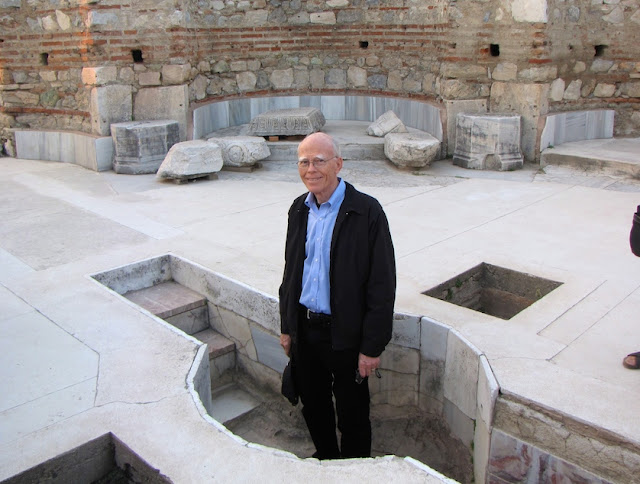We went back and visited the Blue Mosque we had seen last night.
You have to take your shoes off to go in. They give you a little plastic bag to carry them with you.

The name Blue Mosque comes from these blue tiles that are used all over.
It's pretty "modern" as things in Turkey go--1616. That's AFTER the time of my Glastonbury Grail characters so it doesn't feel so ancient given the other stuff we've seen.
The plaza where we walked last night in front of the Blue Mosque turned out to be the Hippodrome--the stadium for chariot races from Constantine's time. The Romans were the ones who brought this obelisk from Egypt, originally to Rome before Constantine shipped it here (although he was dead and there was a new emperor by the time it arrived). The stadium seats have long since been recycled to build none other than the Hagia Sophia, but the long plaza remains.
The Hagia Sophia has been a church and a mosque and is now a museum. A wooden church was built here in the fourth century. It burned and was rebuilt. This third version dates from the sixth century.
It was pretty hard to photograph since it is dark and full of scaffolding on one side at the moment. The windows that are there tend to come out so bright in my pictures that they overwhelm to parts I really was trying to photograph, but here is an idea. I would have liked to be there without a tour so I could just absorb instead of listening to information.
We got in on another carpet pitch as part of the tour. This one was way more cosmopolitan, upscale, urbane. I preferred the co-op outside Pergamum, but these carpets too were gorgeous. If I had a few million dollars and the house to go with them...
Actually, I bought two room size carpets here outside the Grand Bazaar--for my doll house.
The guide warned us--look inside, but buy outside for better prices.
We also visited the Egyptian Spice Market, so called because it was built with the tribute from Egypt under the Ottoman Empire. This mosque is across the plaza. There are more than 3000 in the city, minarets in every direction.
Afternoon boat trip on the Bosphorus. Ironically, this fort on the European side was finished in 1452--one year before the fall of Costantinople. Not very effective in the new age of gun powder, I guess!
Bought a loaf of wonderful Turkish bread and some cheese for supper, then off to bed. We will be picked up at 3:30 AM for the airport. Istanbul is definitely a city I could spend more time in. We didn't tour any of the palaces, or walk down enough narrow streets. :-)



























































